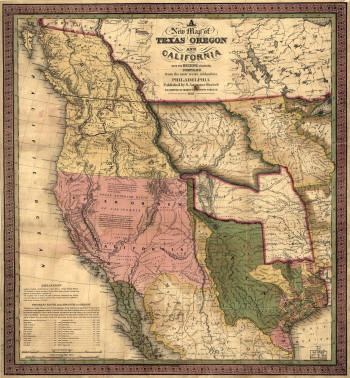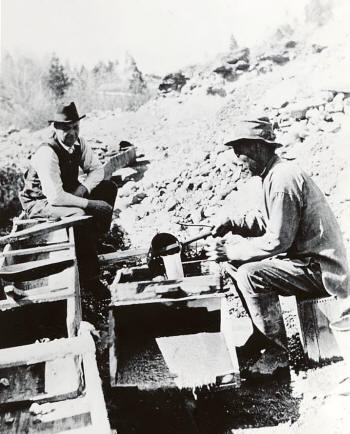California
![]()
This Site:
 California, the largest of the Pacific coast States; noted for its admirable climate, its production of gold, its large commerce, and its great yield of fruit, which now finds a market even in Europe. In recent years the production of gold has decreased, but there has been a remarkable development of other mineral resources, especially petroleum. In 1534 HERNANDO CORTEZ sent Hernando de Grijalva on an errand of discovery to the Pacific coast, who probably saw the peninsula of California. Twenty-five years before the Spanish leader discovered the country, a romance was published in Spain in which are described the doings of a pagan queen of Amazons, who brought from the " right hand of the Indies " her allies to assist the infidels in their attack upon Constantinople. The romance was entitled Esplandian, the name of an imaginary Greek emperor, living in Stamboul, the Turkish name of Constantinople. The Amazonian queen was named Calafia, whose kingdom, rich in gold, diamonds, and pearls, was called California. The author probably derived the name from California, the title of a successor of Mohammed. The author says: " Know that on the right hand of the Indies there is an island, called California, very close to the Terrestrial Paradise, and it was peopled by black women without any man among them, for they lived in the fashion of the Amazonia. They were of strong and hardy bodies, of ardent courage, and of great force. Their island was the strongest in all the world, with its steep cliffs and rocky shore. Their arms were all of gold, and so was the harness of the wild beasts which they tamed and rode. For in the whole island there was no metal but gold. They lived in caves wrought out of the rocks with much labor. They had many ships with which they sailed out to other countries to obtain booty." Both Cortez and Grijalva believed, as everybody then believed, that they were in the neighborhood of the coast of Asia; and, as the aspect of the country corresponded with the description in the romance, they named the peninsula California. In the Gulf of California were found pearls; so the description of the country of the black Amazons—a country filled with gold and pearls—suited the actual condition of the region explored. Although parts of the present territory of the State are believed to have been discovered about 1534, settlements in Old or Lower California were first made in 1683 by Jesuit missionaries. New or Upper California was discovered later, and the first mission there (San Diego) was planted in 1768. For many years the government of California, temporal and spiritual, was under the control of monks of the Order of St. Francis. It was not until about 1770 that the Bay of San Francisco was discovered, and in 1776 a mission was established there. At the beginning of the nineteenth century eighteen missions had been established in California, with over 15,000 converts. The Spanish power in California was overthrown by the Mexican revolution in 1822, when the government was permanently secularized. In 1843–46 many thousand emigrants from the United States settled in California.; and when the war with Mexico broke out in 1846, the struggle for the mastery in that Pacific coast province speedily ended in victory for the Americans in 1847. By the treaty of GUADALUPE HIDALGO, California and other territory were ceded to the United States. Gold Rush
Prior to the assembly of the constitutional convention the people of California, in convention at San Francisco, had voted against the admission of the slave-labor system in that country. The constitution adopted at Monterey also had a provision to exclude slavery from the State. Thus came into political form the crude elements of a State, the birth and maturity of which seems like a strange dream. All had been accomplished within twenty months from the time when gold was discovered at Sutter's Mill. Under this constitution JOHN CHARLES FREMONT, and WILLIAM M. GWIN were chosen by the State legislature United States Senators. Edward Gilbert and G. H. Wright were elected to the House of Representatives. When Fremont and Gwin went to Washington, they took the State constitution with them, and presented a petition (February, 1850) asking for the admission of California into the Union as a free and independent State. The article in its constitution which excluded slavery became a cause of violent debate in Congress and of bitter feeling in the South against the people of the North. The Union, so strong in the hearts of the people, was shaken to its centre. Mr. Clay again appeared as a compromiser for the sake of peace and union. It seemed that some compromise was needed to avoid serious difficulty, for already the representatives of the slave interest had taken action, and the Southern members in Congress boldly declared their intention to break up the Union if California should be admitted under such a constitution. A joint resolution was adopted to appoint a committee of thirteen (six Northern and six Southern members, who should choose the thirteenth) to consider the subject of a territorial government for California, New Mexico, and Utah, with instructions to report a plan of compromise embracing all the questions thus arising out of the subject of slavery. Henry Clay was made chairman of that committee. He had already presented (Jan. 25, 1850) a plan of compromise to the South, and spoke eloquently in favor of it (Feb. 5) ; and on May 8 he reported a plan of compromise in a series of bills, intended to be a pacification. This was called the OMNIBUS BILL. It made large concessions to the slave-holders, and yet it was not satisfactory to them. For months a, violent discussion of the compromise act was carried on throughout the country, and it was denounced upon diametrically opposite grounds. It finally became a law, and on Sept. 9, 1850, California was admitted into the Union as a State. So lawless were a large class of the population at this time, that nothing but the swift operations of " Vigilance Committees " could control them and preserve social order. The first vigilance committee of San Francisco was organized in 1851. Finally, these committees assumed the functions and powers of judges and executives, but under proper regulations, which guaranteed all accused persons a fair trial. Dangerous men of every kind were arrested, tried, hanged, transported, or acquitted. The tribunal became a " terror to evildoers." Late in 1856 the vigilance committee in San Francisco surrendered its powers to the regularly constituted civil authority. California furnished 15,725 three year volunteers for the Union army in the Civil War. The Central Pacific Railroad was completed May 12, 1869, thus connecting California with the Mississippi Valley and the Atlantic seaboard. Since then the progress of the State has been phenomenal. From 1767 up to 1821, California being under Spanish rule, ten governors were appointed by that power. From 1822 until 1845, being under Mexican domination, her governors (twelve) were appointed from Mexico. |
![]()
|
Site Copyright © 2003-2018 Son of the South. For questions or comments, contact paul@sonofthesouth.net. |
|
|
|
Are you Scared and Confused? Click Here to read My Snake Story, a story of hope and encouragement, to help you face your fears. |
||
 In
the month of February, 1848, gold was discovered in California, on the
Sacramento River, by John W. Marshall, who was working for JOHN A.
SUTTER, and as the news spread abroad, thousands of enterprising and
energetic men flocked thither, not only from the United States, but from
South America, Europe, and China, to secure the precious metal. Very
soon there was a mixed population of all sorts of characters in
California of at least 250,000 persons. The military governor called a
convention to meet at Monterey, Sept. 1, 1849, to frame a State
constitution. One was formed by which slavery was to be excluded from
the new State; and this document revived in Congress, in great
intensity, debates on the subject of slavery in 1849-50. See
In
the month of February, 1848, gold was discovered in California, on the
Sacramento River, by John W. Marshall, who was working for JOHN A.
SUTTER, and as the news spread abroad, thousands of enterprising and
energetic men flocked thither, not only from the United States, but from
South America, Europe, and China, to secure the precious metal. Very
soon there was a mixed population of all sorts of characters in
California of at least 250,000 persons. The military governor called a
convention to meet at Monterey, Sept. 1, 1849, to frame a State
constitution. One was formed by which slavery was to be excluded from
the new State; and this document revived in Congress, in great
intensity, debates on the subject of slavery in 1849-50. See